
Amazon FBA Fees in 2023: Full Breakdown

Table of Contents
- Introduction
- Full List of Amazon FBA Fees
- Account/Subscription Fees
- Sales Related Fees
- Referral Fees
- Variable Closing Fees
- Refund Administration Fees
- Miscellaneous Fees
- What Percentage Does Amazon Take From Sellers?
- How Can I Calculate My Amazon Selling Fees?
- What Percentage of Amazon Sellers Make a Profit?
- How Does Amazon Pay Sellers?
- Conclusion
Introduction
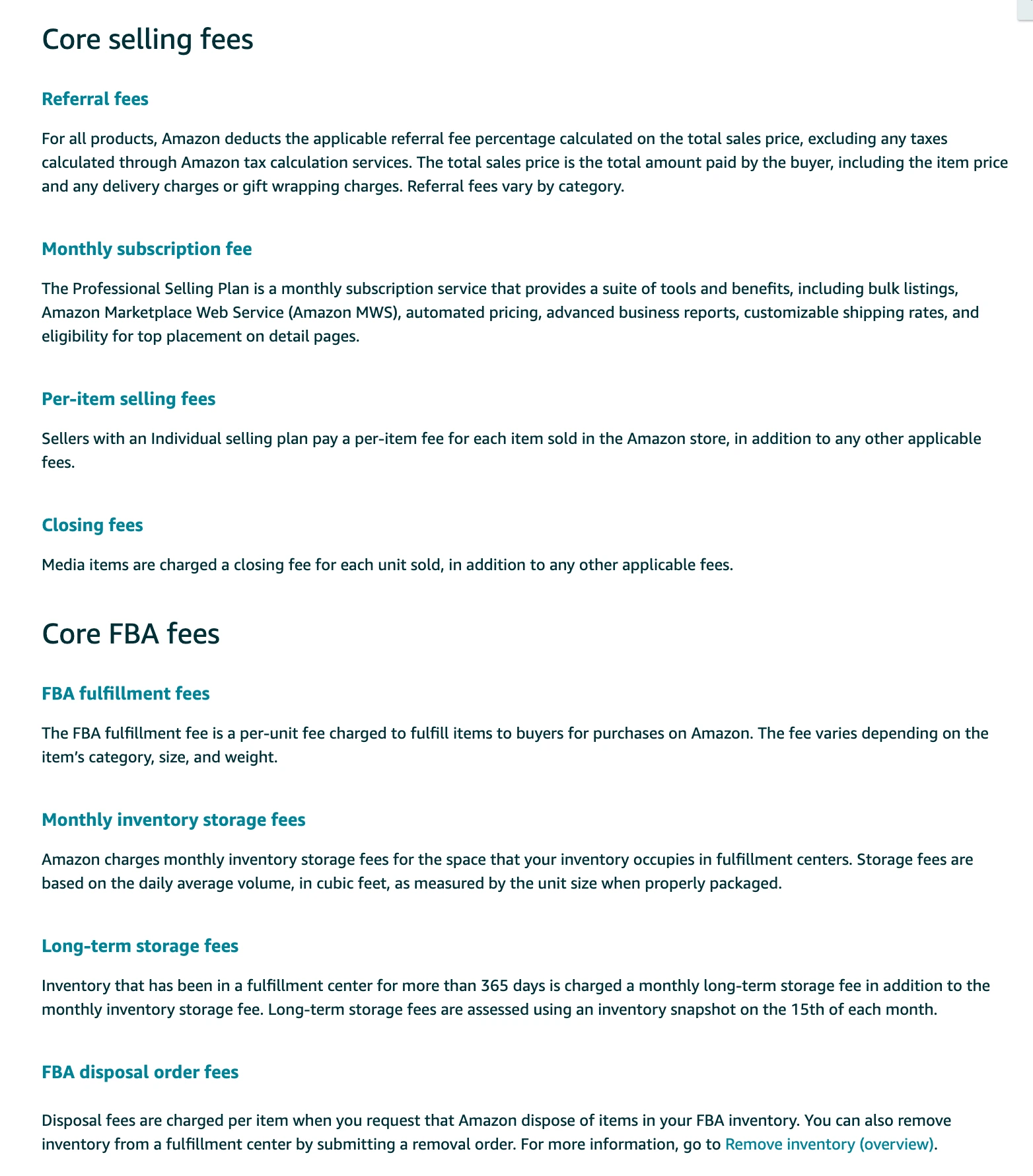
Considering starting an Amazon FBA (Fulfillment by Amazon) business?
Maybe you’ve been curious about what fees you’ll need to account for while Amazon takes care of all the nitty-gritty stuff like storing, packing, and shipping your products. Sure, being in the FBA program means your products can get that sweet Prime badge, which makes customers more likely to buy from you. But hey, you’ve still got Amazon seller fees in the form of referral fees, fulfillment fees (dependent on the size and weight of your items), storage fees for keeping your stock in Amazon’s warehouses, and even long-term storage fees if your stuff chills there for too long.
Yet despite the costs, the convenience and access to a massive customer base make Amazon FBA a pretty enticing option for many online businesses. So while it’s a trade-off, it is a potentially lucrative one at that which is well worth considering.
What costs you ask? Here’s the full list of Amazon FBA fees you might incur.
Full List of Amazon FBA Fees
Account/Subscription Fees
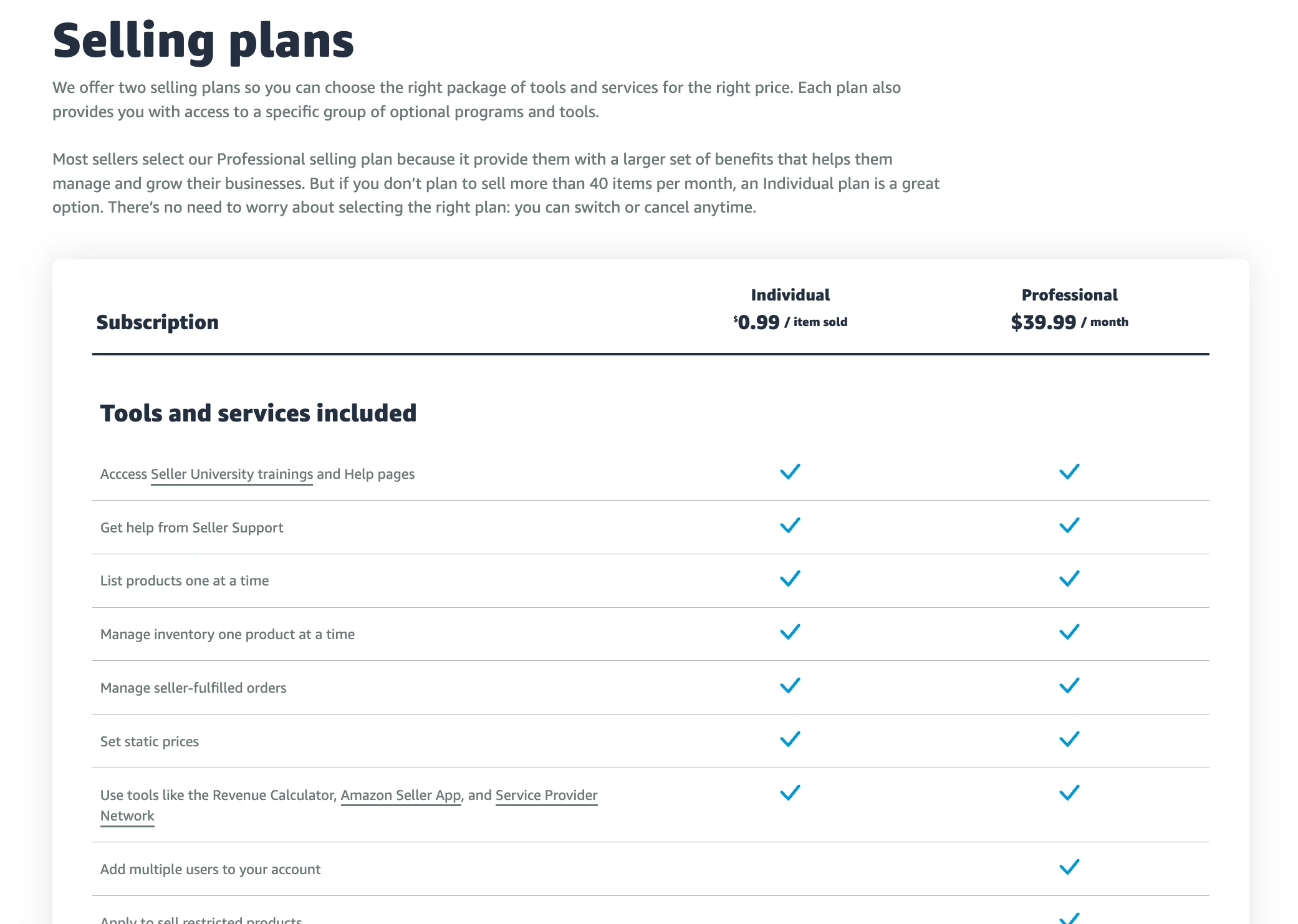
One of the first decisions you’ll make as an Amazon seller is choosing the right account plan. Amazon offers two options: the Individual plan and the Professional plan. The Individual plan doesn’t have a monthly subscription fee but comes with a $0.99 per item sold fee. On the other hand, the Professional plan costs $39.99 per month and is best suited for high-volume sellers who benefit from the reduced per-item fee.
You can read up more on the differences here.
Sales Related Fees
Then, there are sales related fees. Sales-related fees for selling on Amazon FBA (Fulfillment by Amazon) encompass charges and costs associated specifically with the sale of products on the Amazon platform and are attributed to sellers as a percentage of their total sales price.These costs more so exist to cover the services provided by Amazon in the fulfillment and distribution of the seller’s products. Let’s breakdown some key sales-related expenses into individual metrics.Fulfillment & Shipping FeesNaturally, there are fulfillment fees. (You didn’t think fulfillment would be free, did you?)In return for taking advantage of its widespread fulfillment network, you sustain costs for tapping into their trusted distribution network.Fulfillment by Amazon helps streamline the shipping process taking care of refund management & support, inventory storage, counting, picking, packing, and shipping.Amazon also offers discounted shipping rates for its sellers, but you have the option to manage your own shipping if you choose to be it on your own or through a 3PL. Once your products are in Amazon’s fulfillment network, fulfillment fees apply. Fees are based on the size and weight of your products. As you would assume, larger and heavier items typically have higher fulfillment fees.Storage FeesAs for FBA storage fees, those change based on the dimensions, weight and time frame of products being stored in Amazon’s fulfillment centers.Determined by the amount of space your products occupy, you may encounter both standard-size and oversized storage fees.
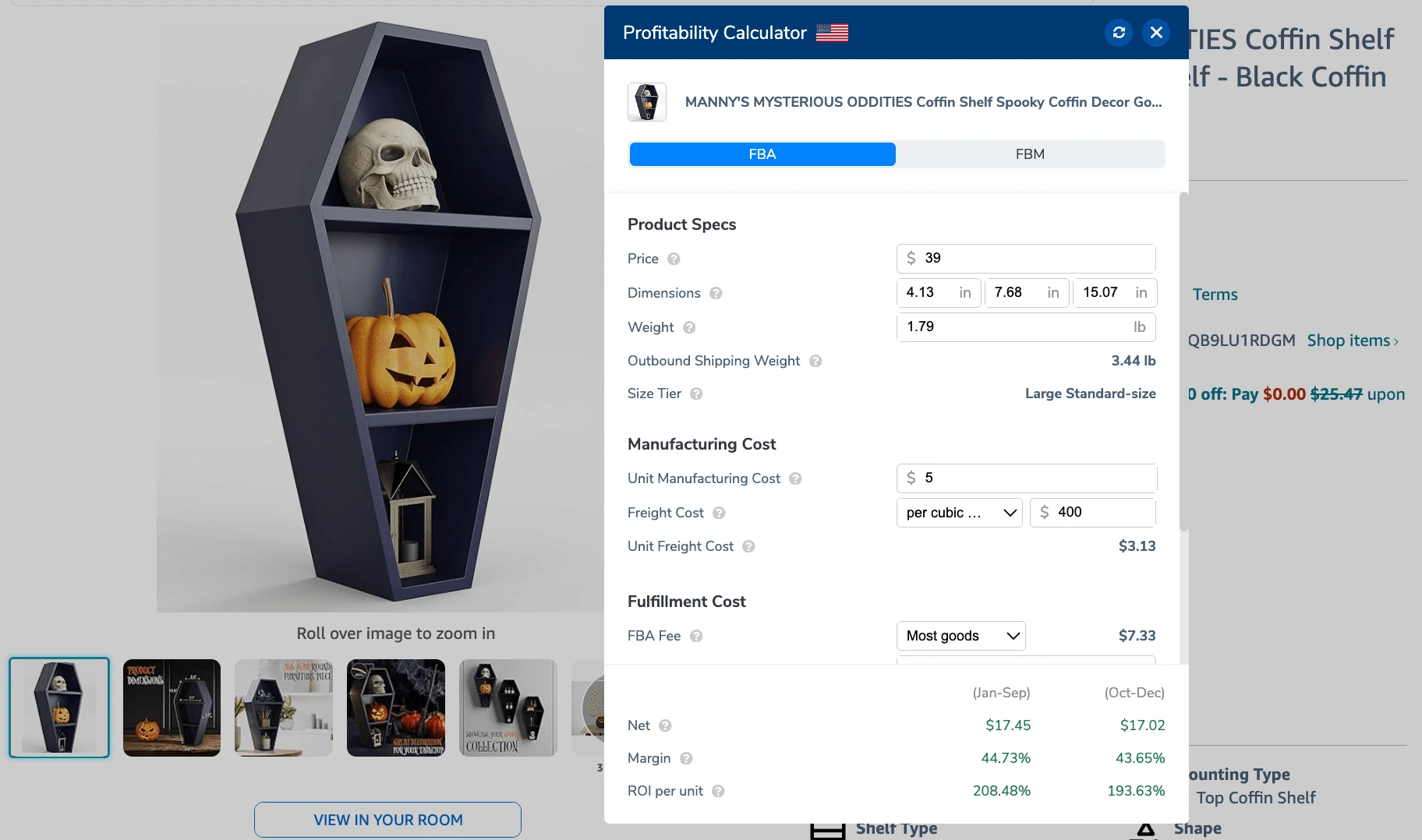
Inside of our profitability calculator, you can also see that in the case of our Manny’s Mysterious Oddities coffin shelf, our tool estimates that fees vary based on time of year. If you scroll down on fulfillment cost, you will also find a field for months in storage to understand long-term storage fees.
Long-term storage fees apply to items stored for an extended duration, encouraging sellers to manage their inventory efficiently. Optimize your inventory management to reduce the need for long-term storage and, in turn, mitigate associated fees.
Referral Fees
Referral fees are calculated as a percentage of the total sales price, which includes not only the item’s cost but also the shipping fees, different product categories have varying referral fee percentages.
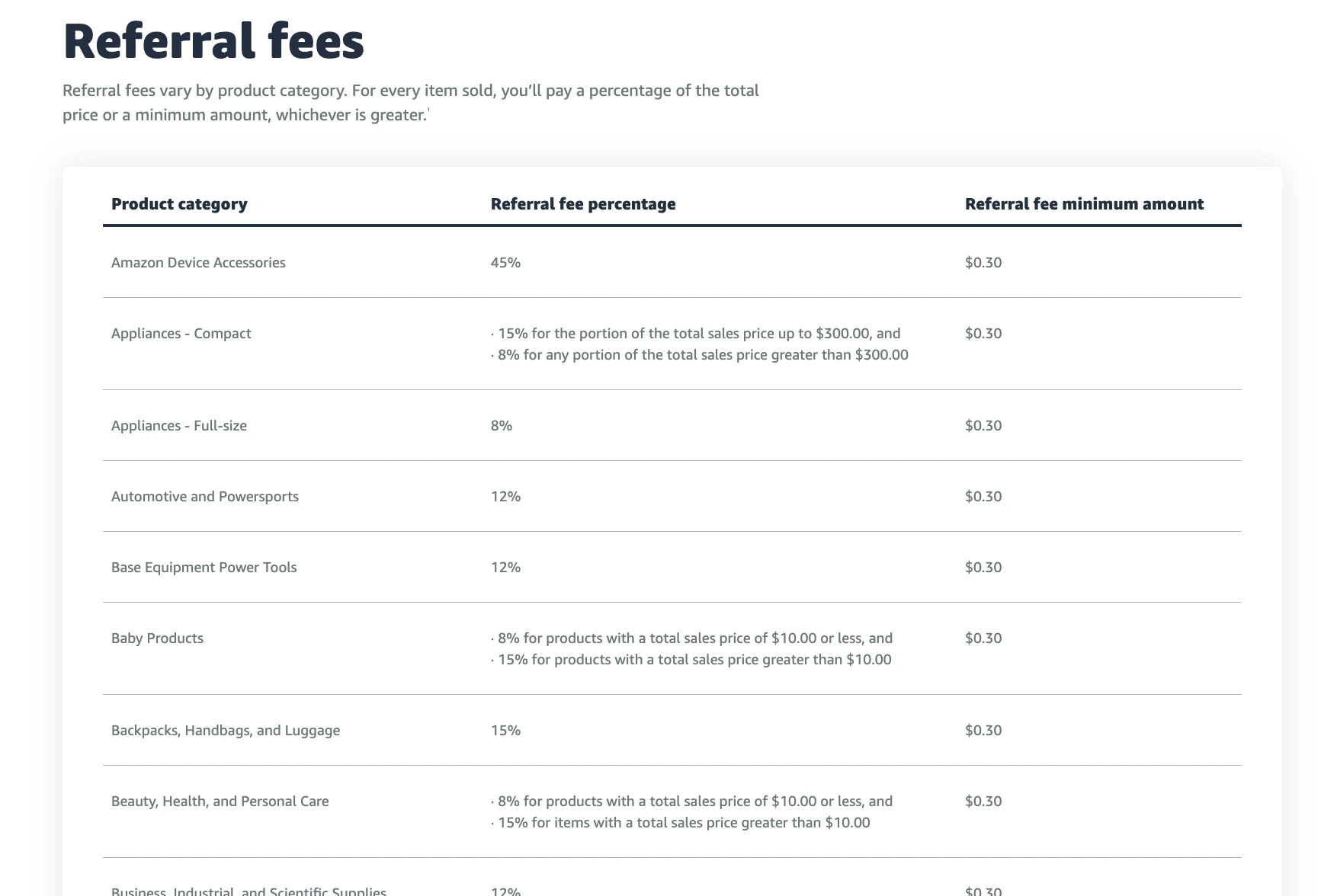
For instance, the referral fee for electronics may be higher than that for books. In some categories, there are minimum referral fees.
The referral fee is a fundamental charge that applies to all third-party sellers on Amazon. Essentially, it’s the cost you pay to Amazon for the privilege of using their online marketplace and gaining access to their vast customer base.
This fee is typically a percentage of your sales, and it varies by product category. Say you sell a product for $100, Amazon might charge you a referral fee of $15, which equals 15% for the Pet Supplies category. It’s as if Amazon acts like your affiliate, bringing in traffic and exposure while you sit back and do little more than list your items for sale. The exact referral fee percentage can fluctuate; most categories hover around 15%, but it can be as low as 6% or as high as 45% in certain categories.
To stay updated on the latest referral fees for each category, you can check the information on Seller Central for North America and Europe. Additionally, there’s the FBA fee to consider as well.
Variable Closing Fees
Variable closing fees may also apply, and these are charged per item sold. The specific amount well…varies by category. These fees are applied to specific product categories and are levied per item sold.
For high-volume sellers, the specter of High Volume Listing Fees may emerge when exceeding the maximum allowable listings for your seller account type. These fees are in addition to referral and fulfillment charges and vary by category.
Understanding your Amazon FBA costs comprehensively includes factoring in these Service Fees and recognizing the flexibility of managing your own shipping rates.
Refund Administration Fees
In the case of refunds, Amazon may charge a refund administration fee, which like most of the other fees, also situates upon the product’s category and the reason for the refund. As an example, a refund for a damaged item may result in a different refund administration fee compared to a return initiated by the customer for a different reason.
If you don’t know what the Refund Administration Fees is, it plays a part in the Amazon FBA seller fees structure and is designed to cover the administrative costs associated with processing refunds.
Either way, you will want to be certain to consider the potential impact of these fees when estimating your business costs as a little can quickly turn into a lot impacting the bottom line of your business. Accurately estimating Refund Administration Fees allows sellers to make informed financial decisions and uphold a profitable presence on Amazon.
Miscellaneous Fees
Lastly, there are miscellaneous fees to be aware of. These fees apply in specific situations and product categories though they are not applicable to all Amazon FBA sellers.
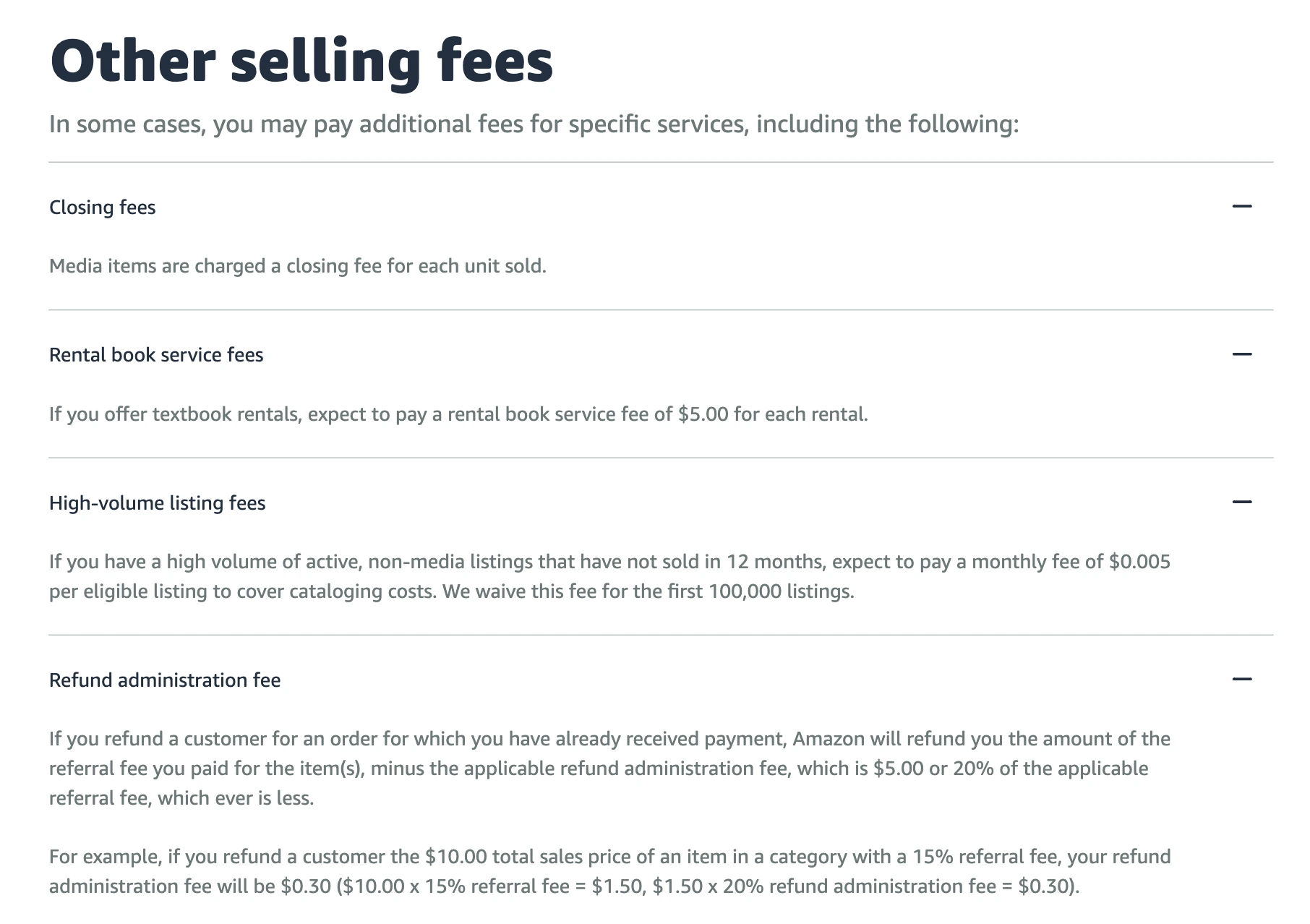
Say there are high-volume listing fees where if you have excessive active, non-media listings that have not sold in 12 months, you will need to pay a monthly fee of $0.005 per eligible listing to cover cataloging costs. Exceptions apply.
Miscellaneous fees can add up. Check in to stay up to date as regulations can change anytime and impact your Amazon FBA business more than you would like it to.
What Percentage Does Amazon Take From Sellers?
Hard to say unless I knew what product category you are selling in, what your fulfillment method is, what kind of selling plan you have and understood what your volume, disposal and storage fees looked like.
However, as I mentioned above, referral fees are determined as a portion of the price at which you sell your product. The majority of sellers typically incur a referral fee ranging from 8% to 15%, but these fees can escalate to as high as 45%, contingent on the product categories to which your items belong.
How Can I Calculate My Amazon Selling Fees?
To help with this, you can use tools like the Helium 10 FBA calculator to understand the costs associated with selling on Amazon. Here’s how you can calculate your Amazon selling fees using the Helium 10 FBA calculator:
- Gather Information:
- Start by collecting all the necessary information related to your product, including the product category, dimensions, weight, and your selling price.
- Access Helium 10 FBA Calculator:
- If you’re not already a Helium 10 user, sign up for an account, download our Chrome Extension and access our FBA calculator tool by clicking on the on browser icon once you are on a product listing page.
- Enter Product Details:
- In the Helium 10 FBA calculator mentioned above, enter the product details, including the category, dimensions, and weight. This information is crucial because it determines your referral fee and fulfillment fees.
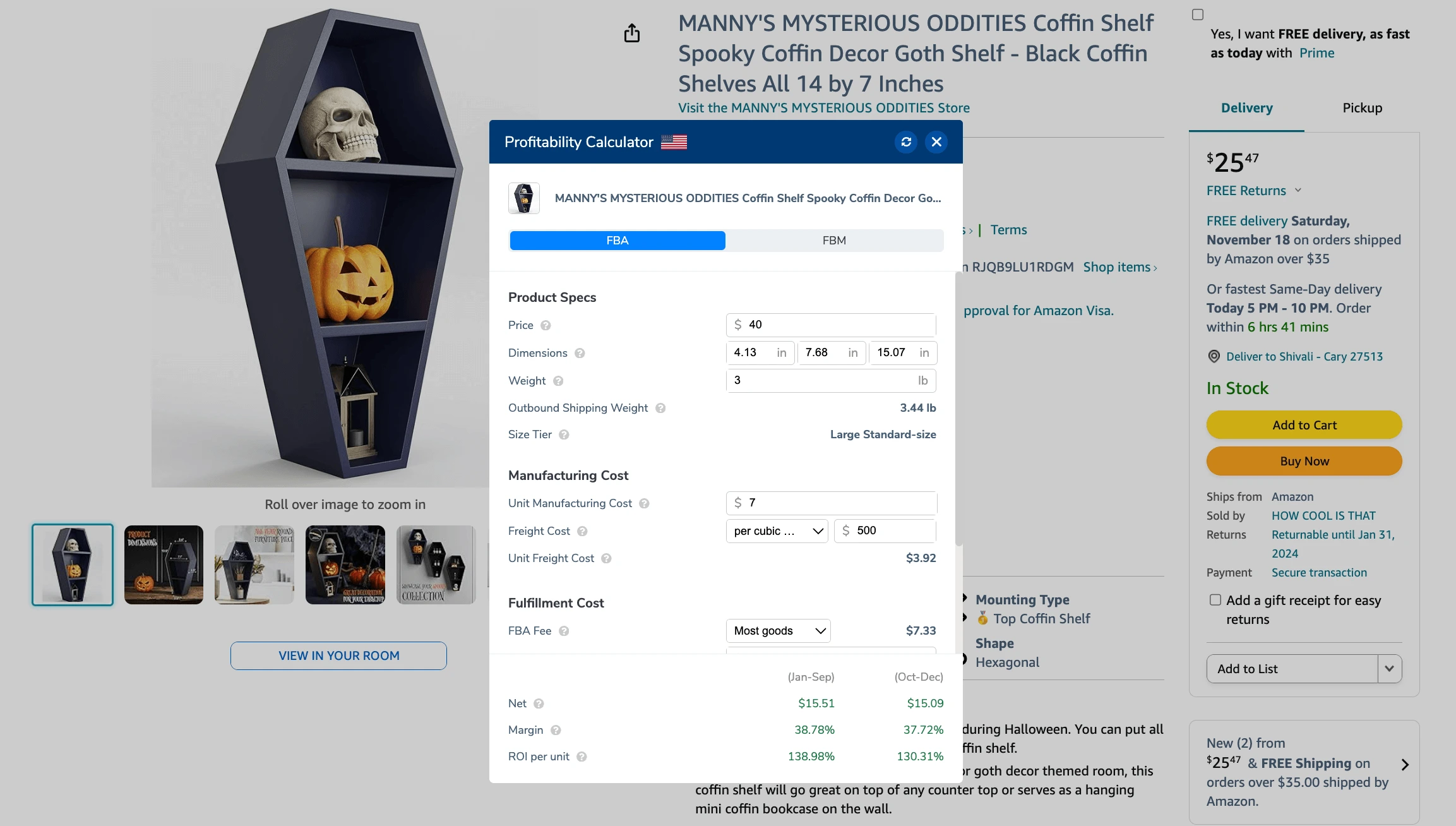
- Choose Fulfillment Method:
- Select the appropriate fulfillment method, such as “Fulfillment by Amazon” (FBA) or “Fulfilled by Merchant” (FBM).
- Input Your Selling Price:
- Enter the price at which you intend to sell your product on Amazon.
- Calculate:
- Click the “Calculate” or similar button within the tool.
- Review the Results:
- The Helium 10 FBA calculator will provide you with a breakdown of your Amazon selling fees. This will include the referral fee, fulfillment fees (for FBA or FBM), and any other associated fees. You’ll also get an estimate of your net profit after fees.
- Evaluate the Results:
- Analyze the results to understand your cost structure, expected profit margin, and to determine whether your pricing strategy is viable.
It’s important to note that the Helium 10 FBA calculator can provide you with a solid estimate of your Amazon selling fees, but actual fees may vary based on factors like promotions, changes in Amazon’s fee structure, or temporary discounts. Therefore, it’s a good practice to regularly update your fee calculations and stay informed about changes to Amazon’s policies and fee structure. This will help you make more accurate financial decisions for your Amazon business.
What Percentage of Amazon Sellers Make a Profit?
The percentage of Amazon sellers who make a profit varies widely and depends on various factors, including the seller’s business model, products, pricing, marketing strategies, expenses, and overall business acumen. It’s challenging to provide a precise figure, as Amazon’s seller ecosystem is diverse, ranging from small businesses and individuals to large enterprises.
Many sellers do turn a profit on Amazon, but the level of success can differ significantly. Some sellers have highly profitable businesses, while others may struggle to break even. Factors that influence profitability include product selection, competitive pricing, efficient inventory management, marketing efforts, customer service, and the ability to adapt to changing market conditions.
To improve your chances of making a profit as an Amazon seller, you should strive to conduct thorough market research, choose the right products, calculate costs such as the Amazon seller fee, applicable referral fee effectively, optimize your listings, and provide excellent customer service. Afterall, success on Amazon often requires dedication, strategic planning, and continuous learning to stay competitive.
How Does Amazon Pay Sellers?
Sellers who operate on Amazon must contend with various fees and expenses related to their earnings. Amazon, functioning as an intermediary, acquires payments from customers and issues payouts to sellers via its Seller Central platform. Earnings are determined by considering multiple fees, including the referral fee, which is a percentage of the total sales price, and may also encompass charges such as the refund administration fee or minimum referral fee.
Payment frequency represents a critical facet of the process. Sellers can opt for receiving payments weekly, bi-weekly, or every two weeks, depending on their location and preferences. The closing fee is another component that might affect the seller’s earnings.
Before disbursing funds, Amazon calculates the seller’s earnings by subtracting various fees. This includes referral fees, fulfillment fees (linked to Fulfillment by Amazon FBA), and other relevant expenses. The remaining balance constitutes the seller’s earnings, less the cost of selling, which may encompass shipping costs.
Sellers can track their available balance, the amount ready for disbursement in the forthcoming payment cycle, directly through the Seller Central dashboard. The balance could also be influenced by monthly storage fees, especially for products occupying additional per cubic foot of space in Amazon’s storage.
The payment method is another pivotal aspect of the process. Sellers can pick their preferred payment method, typically involving options like electronic funds transfer (EFT) or receiving a check. In specific regions, Amazon offers the flexibility of receiving payments in local currencies, subject to the applicable seller fees.
On the designated payment date, Amazon commences the payment process. If the seller’s available balance exceeds the minimum disbursement amount, Amazon transfers the earnings to the chosen payment method. Effective communication plays a crucial role in this process, with Amazon disseminating payment notifications and transaction details through Seller Central to keep sellers informed about the payment amount, date, and method.
Sellers should also note that Amazon may retain a portion of their funds in a reserve account. This reserve serves as a buffer against potential refunds, returns, or other contingencies. The specific amounts and durations of these reserves can vary based on a seller’s performance and history.
Ensuring accurate account information, including bank details, is essential for a seamless payment processing experience. By following these steps and staying informed, sellers can effectively navigate Amazon’s payment system and maximize the benefits of their professional selling plan on the platform.
Conclusion
Remember, if it was easy, everyone would be doing it.
Learning how to sell on Amazon takes time and effort, but it IS a lucrative opportunity that requires careful consideration of the fees and costs associated with the platform.
Whether you’re dealing with referral fees, fulfillment fees, storage costs, or other expenses, a thorough understanding of these financial aspects is essential for the success of your Amazon business.
By staying informed, using helpful tools like our Helium 10 FBA calculator, and continuously evaluating your pricing strategy, you can make well-informed decisions to maximize your profitability as an Amazon seller.
We look forward to seeing you thrive in the dynamic and growing world of e-commerce!
Achieve More Results in Less Time
Accelerate the Growth of Your Business, Brand or Agency
Maximize your results and drive success faster with Helium 10’s full suite of Amazon and Walmart solutions.